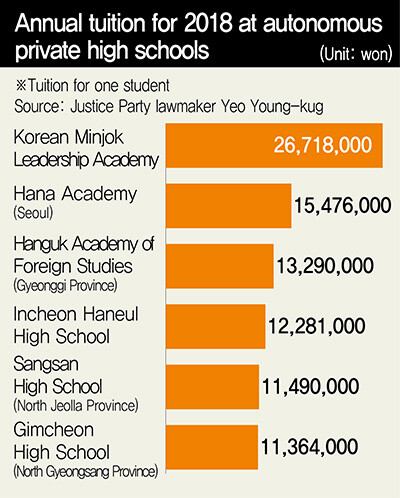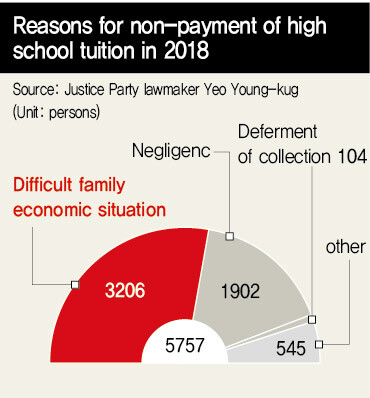hankyoreh
Links to other country sites 다른 나라 사이트 링크
Increasing number of high school students unable to pay tuition fees
Around 5,700 high school students each year are unable to pay school expenses because of their family’s economic situation and other factors, a study shows. Average yearly expenses amounted to 8.86 million won (US$7,405) for autonomous private high schools, reaching as high as 26.71 million won (US$22,325) in one case.
A report titled “Current Status of Reasons for Non-Payment of High School Educational Expenses, 2016–18” received from the Education Ministry on Oct. 6 by Yeo Young-kug, a lawmaker with the

Justice Party, showed the number of students failing to pay educational costs as having risen over the past three years from 5,197 in 2016 to 5,383 in 2017 and 5,757 in 2018. Around half cited their family’s difficult economic situation as a reason for non-payment – a trend that also increased from 2,812 students (54.1%) in 2016 to 3,206 (55.7%) in 2018. Other reasons included “negligence” (33.4% average for the three years), “other” (10.4%), and “deferment of collection” (1.5%).
By region, South Gyeongsang Province had the highest rate of increase in students citing their family’s economic situation as a reason for non-payment over the past three years, with a 5.7-fold rise from 10 students in 2016 to 57 in 2018. Increases in the number of students naming difficult family finances as a reason for non-payment of educational costs were also observed in Busan (from 92 to 165), Ulsan (from 40 to 61), North Chungcheong Province (from 18 to 50), and South Chungcheong Province (from 37 to 76).

As of 2019, high school education costs amount to around 1.6 million won (US$1,337) per student. Yeo Young-kug explained, “More students than expected are having difficulties paying their high school education costs.”
“The National Assembly needs to join forces to swiftly pass legislation for free high school education,” he said. While free high school education was instituted for three-year institutions as of the second semester this year, related bills remain pending in the National Assembly.
Another Education Ministry report received by Yeo on “Annual Education Costs at Autonomous Private High Schools” showed parents of students at South Korea’s 42 autonomous private schools to face an average annual financial burden of 8,864,000 won (US$7,411) based on 2018 final accounts. Specific costs included 76,000 won (US$63.54) for admission fees, 4,181,000 won (US$3,495) for tuition, 1,319,000 won (US$1,102) in school operation support, and 3,288,000 won (US$2,749) in “beneficiary-borne expenses.” The numbers mean parents of students at autonomous private high schools are paying around three times as much as the 2.8 million-won (US$2,340) annual financial burden calculated for ordinary high schools in Seoul as of 2017.
Large differences were also found among autonomous private high schools. The Korean Minjok Leadership Academy had the highest costs overall at 26,718,000 won (US$22,337), followed by Hana Academy Seoul (US$10,265) and Sangsan High School (US$9,604). They were among nine autonomous high schools with annual education costs exceeding 10 million won (US$8,358). Yearly costs for the Korean Minjok Leadership Academy were higher than the average wages for an irregular worker, which totaled 1,644,000 won (US$1,374) per month last year. The least expensive of the schools, Gwangyang Jecheol High School, had costs of 5,694,000 won (US$4,756), or the equivalent of 3.5 months of wages for an irregular worker.
By Choi Won-hyung, staff reporter
Please direct comments or questions to [english@hani.co.kr]
Editorial・opinion
![[Editorial] Intensifying US-China rivalry means Seoul must address uncertainty with Beijing sooner than later [Editorial] Intensifying US-China rivalry means Seoul must address uncertainty with Beijing sooner than later](https://flexible.img.hani.co.kr/flexible/normal/500/300/imgdb/original/2024/0517/8117159322045222.jpg) [Editorial] Intensifying US-China rivalry means Seoul must address uncertainty with Beijing sooner than later
[Editorial] Intensifying US-China rivalry means Seoul must address uncertainty with Beijing sooner than later![[Column] When ‘fairness’ means hate and violence [Column] When ‘fairness’ means hate and violence](https://flexible.img.hani.co.kr/flexible/normal/500/300/imgdb/original/2024/0516/7417158465908824.jpg) [Column] When ‘fairness’ means hate and violence
[Column] When ‘fairness’ means hate and violence- [Editorial] Yoon must stop abusing authority to shield himself from investigation
- [Column] US troop withdrawal from Korea could be the Acheson Line all over
- [Column] How to win back readers who’ve turned to YouTube for news
- [Column] Welcome to the president’s pity party
- [Editorial] Korea must respond firmly to Japan’s attempt to usurp Line
- [Editorial] Transfers of prosecutors investigating Korea’s first lady send chilling message
- [Column] Will Seoul’s ties with Moscow really recover on their own?
- [Column] Samsung’s ‘lost decade’ and Lee Jae-yong’s mismatched chopsticks
Most viewed articles
- 1For new generation of Chinese artists, discontent is disobedience
- 2[Editorial] Transfers of prosecutors investigating Korea’s first lady send chilling message
- 3[Column] US troop withdrawal from Korea could be the Acheson Line all over
- 4[Column] When ‘fairness’ means hate and violence
- 5Xi, Putin ‘oppose acts of military intimidation’ against N. Korea by US in joint statement
- 6[Exclusive] Unearthed memo suggests Gwangju Uprising missing may have been cremated
- 7China calls US tariffs ‘madness,’ warns of full-on trade conflict
- 8[Editorial] Intensifying US-China rivalry means Seoul must address uncertainty with Beijing sooner t
- 9S. Korea “monitoring developments” after report of secret Chinese police station in Seoul
- 10For Korea’s Justice Ministry, no place is sacred from immigration raids